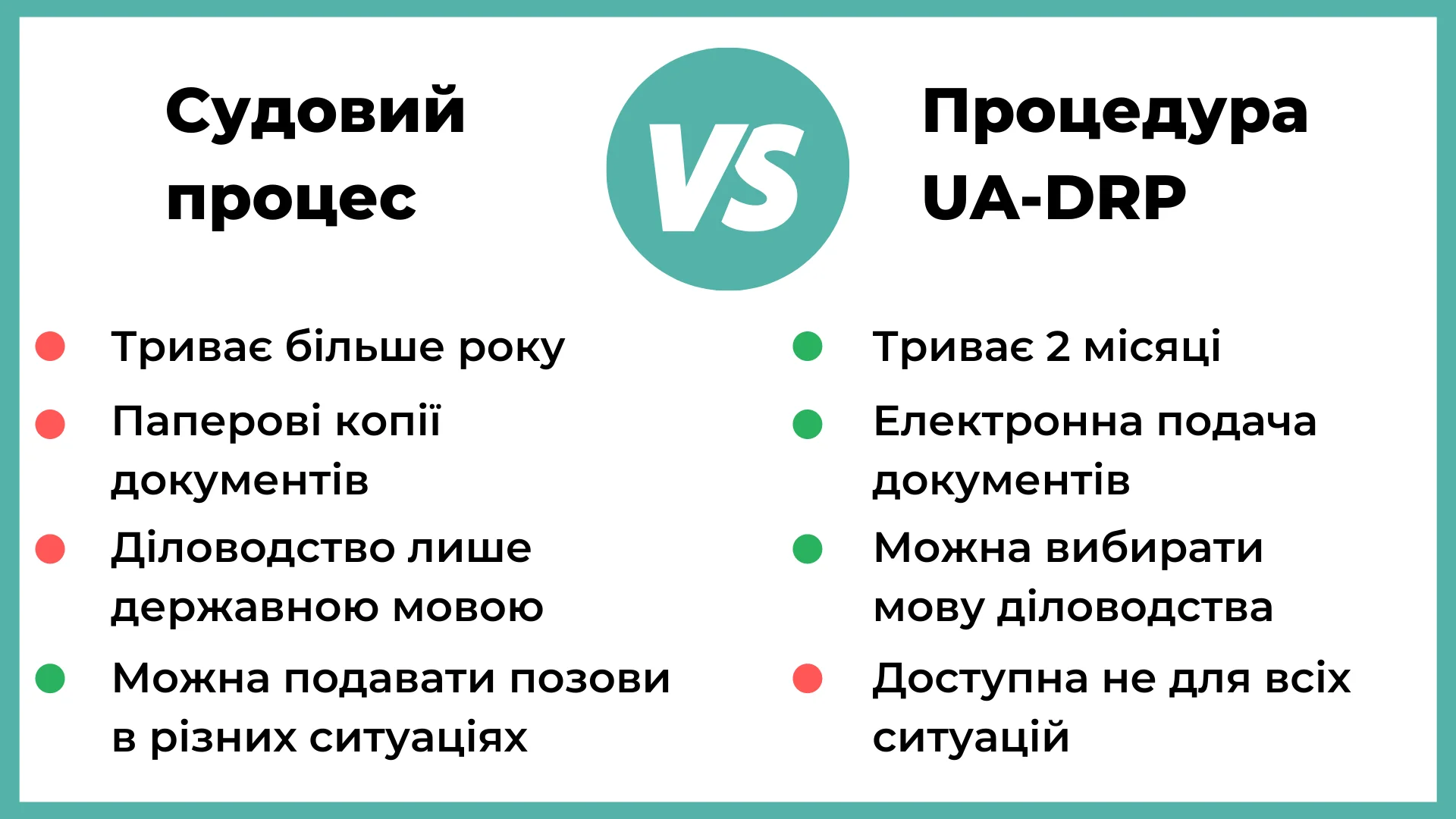
Important elements for business development and functioning are:
- registered trademark;
- availability of patents;
- proper registration of transfer of property rights of intellectual property from employees and contractors;
- domain availability.
All of the above mostly does not have a material equivalent, so sometimes the business may not know whether to skip or save on legal support for these issues. As a result, companies may face cybersquatting, i.e. cyber-grabbing of a domain name.
This practice involves registering domain names that match or sound similar to the brand name. Then, persons who may not be related to the business, dishonestly use such a domain name for their own commercial purposes, in particular for resale. When faced with such a situation, the first thought is to go to court as the most obvious solution. However, this procedure is known to be time-consuming and expensive. Therefore, an alternative is needed.
She is. In addition to the familiar court system, the opportunity to protect yourself from cybersquatting and defend your right to a domain name is available in the UA-DRP procedure, which we will consider in this material.
What is UA-DRP?
UA-DRP is an alternative way to resolve disputes related to domain names. In fact, this is an analogue of a trial, but this procedure is not tied to the judicial system of state authorities. There's also a claim process, which we'll talk about next. However, according to the dispute resolution policy regarding domain names in the .UA zone (hereinafter referred to as the ".UA Rules"), which was approved by "HOSTMEISTER" LLC, a special administrative commission (and not a judge) will consider applications for domain name registration.
It is important to note that participation in the UA-DRP procedure does not deprive the claimant of the opportunity to go to court.
What domains does UA-DRP cover?
The next logical question that arises in the case of a decision to use the UA-DRP procedure concerns the definition of the list of such domains. The administrator of the public domain .UA "HOSTMEISTER" LLC informs that the dispute resolution policy has entered into force for:
- Second-level private domain names in the .UA zone (from March 19, 2019),
- Third-level private domain names in the COM.UA zone (since 12/19/2019),
- Private domain names of the third level in the zones kyiv.ua, kiev.ua, ivano-frankivsk.ua, if.ua, poltava.ua, pl.ua, uzhgorod.ua, uz.ua (from 05.06.2021).
- Private domain names of the third level in the zones cn.ua, chernihiv.ua, chernigov.ua, cv.ua, chernivtsi.ua, chernovtsy.ua, kr.ua, kropyvnytskyi.ua, kirovograd.ua, lt.ua, lutsk.ua, volyn.ua, te.ua, ternopil.ua, uzhhorod.ua, zakarpattia.ua, vn.ua, vinnytsia.ua, vinnica.ua, zt.ua, zhytomyr.ua, zhitomir.ua (from 01.02.2024).
- Third-level private domain names in the zones org.ua, rv.ua, rivne.ua, rovno.ua, km.ua, khmelnytskyi.ua, khmelnitskiy.ua (From November 1, 2024).
Procedure for pre-trial settlement of domain disputes
The very procedure for settling domain disputes under the .UA Rules has similar features to classic court proceedings — for example, the impartiality and independence of commission members when considering a case. But it has its own peculiarities.
First, it is important to understand the grounds of the dispute.
They include three important conditions that the plaintiff must prove:
- the domain name is identical or deceptively similar to a mark for goods and services to which the plaintiff has rights;
- the owner has no rights or legal interests in the domain name;
- the domain name is registered or used fraudulently.
Secondly, remember the following features:
-
Filing a lawsuit is accompanied by both classic requirements regarding the list of information that must be reported or provided, and a feature of the UA-DRP procedure itself. The plaintiff can indicate his wishes regarding the composition of the commission members who will consider the case. At the same time, the lawsuit itself is submitted directly to the WIPO Center.
-
The WIPO Center, upon receiving a claim, carries out a number of procedures, in particular, it sends the claim to the defendant and notifies the parties of the date of commencement of administrative proceedings.
-
The defendant has the right to file objections, confirming in such objections the authenticity of the information presented by him.
-
The WIPO Center shall notify the parties of the appointment of the members of the Commission and the date by which, in the absence of exceptional circumstances, the Commission shall issue a decision.
A feature of such pre-trial settlement of the dispute is also that, as a general rule, the parties do not participate in hearings. In general, the UA-DRP procedure itself is more simplified than a trial in the same commercial court.
Read also: Scammers on Facebook – How to Protect Your Business Page from Theft
Why is UA-DRP better than court?
Alternative dispute resolution methods, such as UA-DRP, always have their advantages over the classic court system. They are more flexible and have quick turnaround times.

Submission of documents. The rules of the UA-DRP policy do not bind the parties with strict requirements for submitting a claim in paper form with a description of the attachment. But even though the "Electronic Court" system has already been launched and is gradually beginning to simplify various court procedures, some modules still do not work. Therefore, in order to comply with all the requirements of procedural codes, sending paper copies with a description of the case by the parties is a guarantee that your claim will not be left without movement. At the same time, the .UA Rules themselves establish the submission of a claim in electronic form, but in the case of sending claims to the defendant, the WIPO Center itself is obliged to use all possible methods to actually notify the defendant.
The language of the procedure. Another example of the flexibility of the UA-DRP process can be considered the choice of the language of record keeping. According to the current Ukrainian legislation, the court process takes place only in the Ukrainian language. Accordingly, if there is a need for another language, all the evidence will have to be translated or a translator requested. At the same time, the .UA Rules assume that the parties can agree on the choice of language (Ukrainian, English, Russian, and others).
Deadlines. As for terms, compared to classic court proceedings, which often last more than a year, the procedure for resolving domain disputes for the .UA zone takes up to 2 months on average.
Is it possible to protect against cybersquatting?
Let's start with the fact that, in general, the legislation of Ukraine does not sufficiently regulate the issue of combating such a phenomenon as cybersquatting. At the same time, one of the most popular tools for protecting your business is the presence of a registered trademark , especially when using a top-level domain name. Trademarks are widely used by businesses, because they create an association for the consumer. Therefore, the defense argument is the fact that the seizure of a domain name similar to a trademark is a violation of the rights of the TM owner. In this situation, having a registered trademark makes it possible to protect your business in domain disputes.

In the case of business domain disputes, it is important to understand that the protection of its interests is based on a series of preventive actions and, of course, on prompt response after the fact of conflict is discovered.
Prudence consists in organizing all the intangible assets of your business, conducting a legal audit of them, understanding what problems and risks there are and how to eliminate them. For example, check if you have registered your trademark. If your employees create any intellectual property, have they transferred their ownership of the intellectual property to the company? Has a non-disclosure agreement been signed with all employees? Is an entity legally using a word expression so similar to your business name in a domain name?
When understanding the situation that a domain dispute has already arisen and a rational solution is needed, it makes sense to consider the UA-DRP procedure as an alternative to the classic court system. UA-DRP provides an opportunity not to be bound by the strict framework of Ukrainian procedural legislation and to win in terms of time spent on conflict resolution. At the same time, it is important to understand that UA-DRP cannot be used in absolutely all situations. And even if the UA-DRP procedure seems to be an order of magnitude simpler than the court process, this does not exempt from serious preparation for participation in the UA-DRP or the implementation of preventive measures.








